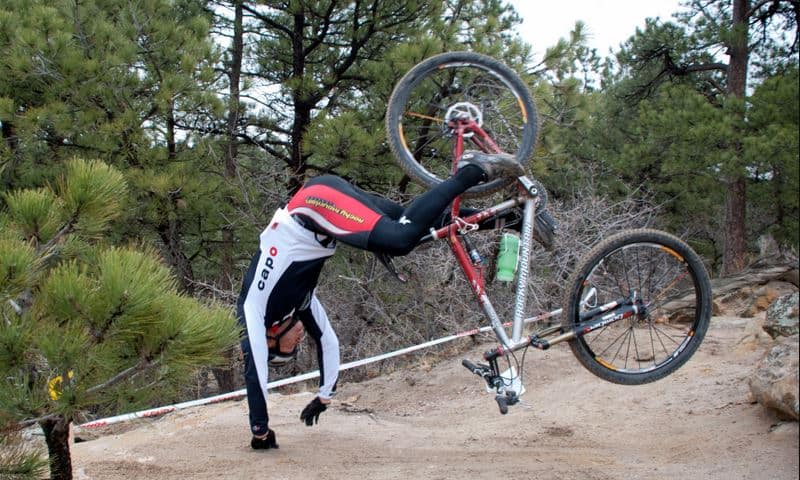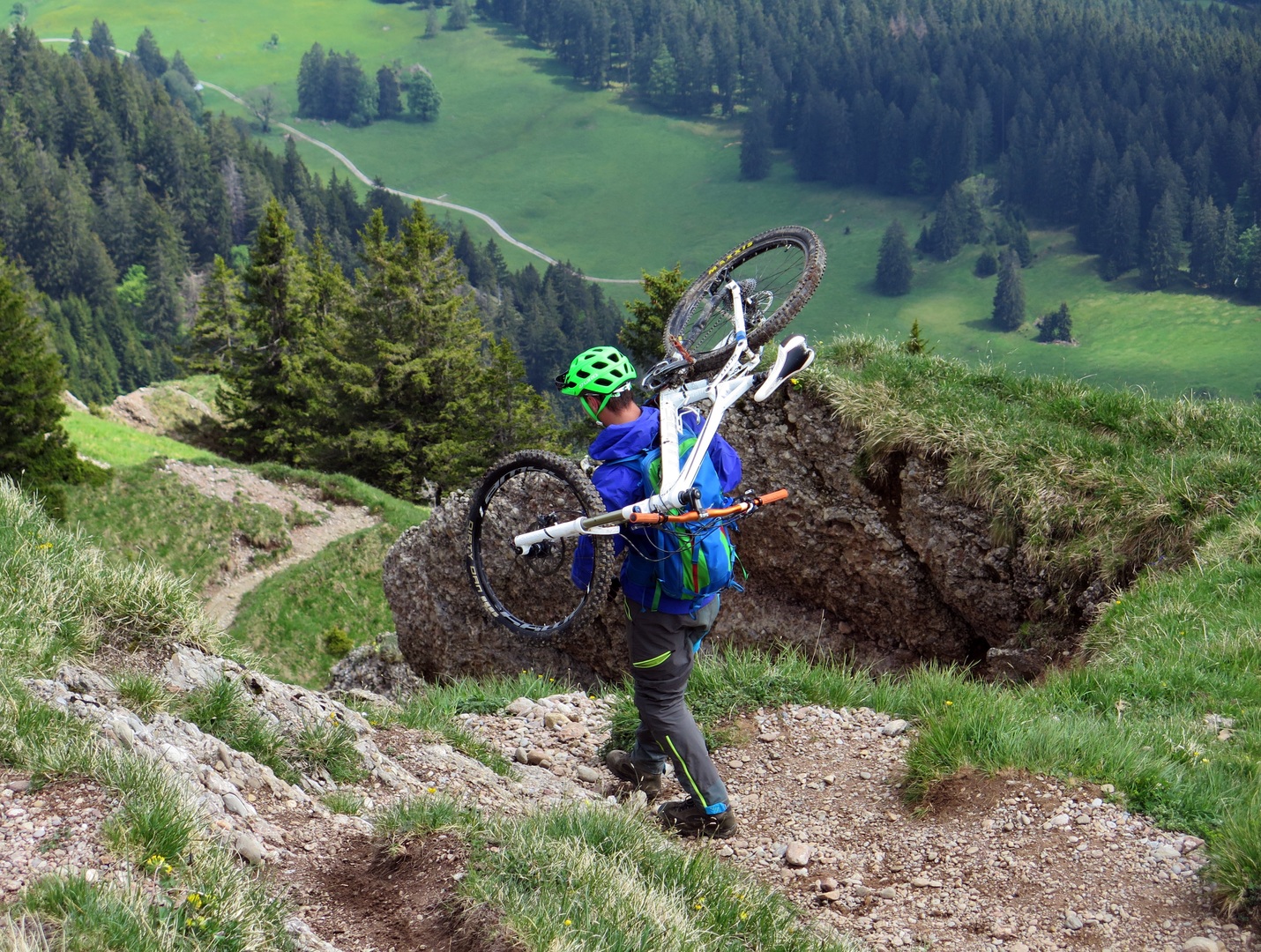Is mountain biking dangerous? You’re likely to get as many different answers as the people you ask. Some don’t think you are really “doing mountain biking” if you’ve never crashed because you were pushing yourself to the edge of your abilities.
In this article, we will try to give a more objective answer to how dangerous mountain biking really is compared to other sports.
How Dangerous Is Mountain Biking Compared To Other Popular Sports?
Mountain biking is one of the most popular outdoor activities in the world. While some people love it, others are afraid of it because of the injuries associated with riding. In fact, there is a lot of research about how dangerous mountain biking actually is compared to other sports.
Injury rates are compared by measuring the number of injuries per 1000 exposures, commonly meaning per 1000 h. To make a fair comparison we will separate the different mountain biking disciplines, Cross-Country, Downhill, and more recreational mountain biking.
The following chart compares the injury rates reported for many different sporting events.

In the chart, we have divided the data based on the form of mountain biking. Studies have shown that Mountain Biking on a recreational level actually results in fewer injuries than running with 1.5 injuries per 1000 h and running at 3.6.
Different Risks with different disciplines: Cross-Country Vs Downhill Mountain Biking
But if we are talking about more advanced riding, like cross-country (XC) and even Downhill mountain biking, the risks of suffering injuries go up. A study from 2017 showed that Downhill had an injury rate of 16.8 per 1000 h and cross-country mountain biking 6.8 per 1000 h.
Another thing that is not reflected in the statistics is the severity of the injuries, it’s just calculating the frequency of injuries. It’s safe to say that Downhill riding could be considered to be riskier than the numbers show if you consider how badly you can get injured.
Cross-country mountain biking on the other hand wouldn’t result in as serious injuries as downhill. That is mainly because it is a more varied discipline where you are not just going downhill, but uphill as well, where you’re not going as fast.
What Are The Most Common Mountain Biking Injuries
There are a lot of different injuries seen from mountain biking ranging from small scratches and bruises to serious injuries. Here are the most common types of injuries from mountain bike accidents.

1. Skin abrasions and other soft tissue injuries: These are lighter injuries that are very common when mountain biking. What’s positive is that they heal quickly and won’t keep you off the bike for long. Keep a small first-aid kit with you when riding so you can treat them immediately.
2. Bone fractures: Fractures to the collarbone, wrists, and lower legs are also common mountain bike injuries. They are more severe injuries that require more time to recover from. Collarbone fractures, in particular, can be tricky to recover from since it’s not as easy to treat as a fracture on e.g a forearm.
3. Concussion or head trauma: Injuries to the head are also very common in mountain biking. Just like with forearm fractures, head trauma is often a result of crashing and crashing and falling forward over the handlebar. This becomes particularly dangerous in downhill riding. Wearing a GREAT helmet will greatly reduce the risk of severe head injuries.
Control The Risks You Can To Make it Less Dangerous
These are risks involved with mountain biking, just like with many other activities. But some of these risks can be controlled and mitigated. This should not be neglected. So make sure to do what you can to stay safe on your rides.
Get in Shape And Prepare (Stretch)
Bikers who ride rough and harsh trails have to suffer extra stress and shock and it all falls upon the body. Work on strengthening your body’s core and improving your physique to avoid serious injuries.
We suggest hitting the gym once or twice in a while and working out, especially on your legs, biceps, triceps, and shoulder muscles.
In the meanwhile, work on improving your stamina and prepare your body in a way that it can bear harsh terrains without any hassle.
Properly Plan Your Route
An unplanned route always becomes a mess and we know it more than anybody else. Before hitting the trail, plan out your route and search for it on the Internet.
If possible, watch a video of that specific route on YouTube to check whether you can handle it or not. If you do not plan your route, chances are that you will easily sustain an injury on the way.
Maintain Your Bike and Equipment
Always double-check the maintenance of your bike before you start regretting your decision. See whether the brakes are good enough and whether the tires can sustain harsh bumps and gravel. Similarly, check the maintenance of the handlebar and see whether it’s offering balance or not.
Apart from that, check all the bolts thoroughly and look for any cracks in the frame. Do that and you will start trusting your bike easily.
As for the equipment, you should always keep a repair kit in your backpack to repair your bike if it gets a puncture or gets stumbled around.
Finally, a first aid kit is a must as it will help you out in covering the wounds if, God Forbids, you develop a hefty injury while biking.
Wear Safety and Protection Equipment
A research study shows that wearing a helmet reduces the chances of head trauma by up to 39%. So, wearing a helmet and a properly tested one is a must for every mountain rider.
On the other hand, don’t forget to wear cycling gloves, knee pads, elbow pads, and proper cycling shoes to protect yourself from unwanted injuries and bruises. If you are doing some serious riding you should consider wearing body armour.
Never wear a half-sleeve shirt while riding your bike on a forest road. Always prefer full-sleeved shirts with comfortable trousers to enjoy mountain riding in its full essence.
Adjust Your Bike
Tune your bike according to the way you ride it. The position of the handlebar, brake lever, and the seat is something you should properly adjust beforehand.
It will allow more comfort and relaxation to you. Plus, you’ll become capable enough to control your bike during downhill riding.
Stay Hydrated
Keep a good quantity of water bottles in your backpack if you think the route will take a lot of time to get completed. Staying hydrated will not only keep you fresh, but you will not make silly mistakes while riding uphill or downhill.
Therefore, don’t forget to keep an abundant supply of water during mountain biking so you can enjoy the whole ride.
Learn from Professional Cyclists
Closely analyze the techniques of professional mountain riders and see how they tackle long jumps and drops. Try to imitate them and you will surely become as good as them gradually.
Don’t be Overconfident
Never try to overcome all obstacles in a single go if it’s your first ride!
Overconfidence kills, and once you get an injury, you will not be able to touch your beloved mountain bike for months. To avoid this problem, don’t be stupid! Find a route that’s easy to cover with fewer bumps if you are a newbie.
Develop your biking skills and once you get comfy enough, find tough routes and complete them accordingly.
Controlled Crashing: Bail Out Have To
There’s no problem or dishonor in bailing out as a beginner. If you cannot overcome an obstacle on the first try, do not become obsessed with it.
Give yourself time and work on your physique. You will improve your skill level as a mountain biker for sure.
Some Risks are Still Uncontrollable
No matter how many precautionary measures you take, mother nature will still trick you in the form of sun glare, wet paths, and sloppy gravel.
So, you will get injured once or twice but with proper safety equipment, you can at least keep your bones and muscles safe from serious risk.
Frequently Asked Questions:
- What are the dangers of mountain biking?
Mountain biking, when done without wearing any safety gear, could become a serious risk factor. Major mountain biking injuries include concussion, head injuries, shoulder dislocation, as well as bone fractures.
- Is mountain biking the most dangerous sport?
It depends on what type of mountain biking we’re talking about. Downhill mountain biking has a lot of risks involved but cross-country riding is less dangerous than Basketball, Hockey, or Soccer.
- Is mountain biking hard on your body?
Mountain biking exerts extra pressure and impact on the rider and absorbing all this pressure could become a little struggle for the body. So, yeah, it is hard for the body to tackle it at the start, but it gets better with time.
Final Takeaways
So, is mountain biking dangerous? Well, we do agree that mountain biking in some forms is an extreme sport and it could cause some serious injuries. But, compared to other sports, the injury rate of the kind of mountain biking most people do is actually lower than in a lot of popular sports.
Always wear your safety gear before hitting the trails and avoid riding in rainy or stormy weather just to be on the safe side.





